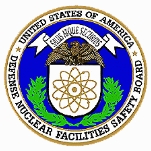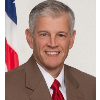The Defense Nuclear Facilities Safety Board is an independent government agency responsible for monitoring and advising the Department of Energy’s management of defense nuclear facilities.
The Defense Nuclear Facilities Safety Board is an independent government agency responsible for monitoring and advising DOE’s management of defense nuclear facilities, some of which today are being dismantled and cleaned up. Under its mandate from Congress, the board is charged with ensuring the implementation of DOE health and safety standards by energy officials and to issue advisory recommendations regarding work at facilities.
Cleaning up the Hanford Mess
Winokur Warns against Loosening Federal Oversight
Dr. A.J. Eggenberger
- Table of Contents
- Overview
- History
- What it Does
- Where Does the Money Go
- Controversies
- Suggested Reforms
- Comments
- Leave a comment


Sean Sullivan, a former naval officer who spent much of his career working on nuclear-powered submarines, was appointed by President Donald Trump on January 26, 2017, to chair the Defense Nuclear Facilities Safety Board (DNFSB). Sullivan had previously been appointed in 2012 by former President Barack Obama as a member of the board. Established in 1988, the DNFSB monitors the nation’s nuclear facilities and advises the Department of Energy on their management, including decommissioning and cleanup.
Sullivan was born November 30, 1958, in Bridgeport, Connecticut. His home-state senator, Lowell Weicker (R), appointed him to the U.S. Naval Academy in 1976. Sullivan graduated in 1980 with a B.S. in marine engineering. In 2002, he earned an M.A. in national security affairs from the Naval War College.
Sullivan’s first shipboard assignment was to the USS Plunger, a nuclear-powered attack submarine. After that, he returned to the Naval Academy as an instructor, and then was assigned to another attack boat, the USS Chicago.
Sullivan worked his way up to become executive officer, or second in command, on the USS Maryland, a ballistic missile sub. After that, he got his first taste of politics when he was sent to Washington as deputy director of the House of Representatives Navy Legislative Liaison Office. In 1996, Sullivan returned to the sea as captain of the USS Jefferson City, a Los Angeles-class attack submarine.
In 1999 Sullivan returned to shore duty, with his career culminating with an assignment beginning in 2004 as the commander of the Naval Submarine Base New London in Groton, Connecticut. He retired from the Navy in 2006 with the rank of captain.
While ending his time in the Navy, Sullivan was preparing for his second career, earning his J.D. from the University of Connecticut in 2006. He worked as a civil litigation attorney for Brown Jacobson, a law firm in Norwich, Connecticut.
Sullivan began his own political career in 2008, when he ran as a Republican for a congressional seat from Eastern Connecticut. He called for an end to the Iraq War, but opposed setting a date for U.S. troops to withdraw. He also called for increased spending for renewable energy, biofuels, fuel cells and nuclear power. His Democratic opponent, Joseph Courtney, had won his first term by only 83 votes, but roughed up Sullivan two years later, winning by a 2-to-1 margin. Sullivan found success in electoral politics the following year, when he won a seat on the Ledyard Town Council. In 2010, Sullivan ran for state senate, calling for deep spending cuts in the state budget and privatizing some social service programs, but lost by 802 votes to the 13-term incumbent, 84-year-old Edith Prague.
In 2011, Sullivan moved back into the world of submarines when he became a partner in Sonalysts, which supported the Navy’s development of its next ballistic missile submarine class.
He worked there until 2012, when he was first appointed to the DNFSB, and resigned from the Ledyard Town Council at that time as well.
Sullivan and his wife, Sharon, have four children: Amy, Kelley, Casey and Max.
-Steve Straehley
To Learn More:
Official Biography (pdf)

On April 7, 2015, President Barack Obama announced his intention to nominate Joyce L. Connery, who has worked on nuclear policy for most of her career, to head the Defense Nuclear Facilities Safety Board, which monitors nuclear facilities, but does not have regulatory power.
The daughter of William and Rose Connery, Connery is from Stoneham, Massachusetts, and graduated from Stoneham High School in 1988. She went to Tufts University to study international relations. She spent a semester studying in Leningrad, Russia, before earning her bachelor’s degree in 1992. The following year, Connery began a two-and-a-half-year stint as a Peace Corps volunteer in Turkmenistan.
Connery returned to Tufts after her tour to work on a master’s degree in law and diplomacy with a concentration in conflict resolution and Southwest Asian area studies. She spent time as an intern in the political section of the U.S. embassy in Kyrgyzstan before earning her M.A. in 1999.
She spent two years at the U.S. embassy in Kazakhstan, first as the Department of Energy’s Nuclear Nonproliferation representative and then as the on-site project manager for the shut-down of the BN-350 nuclear reactor.
She went to work at the Argonne National Laboratory in Illinois in 1999, serving as nuclear nonproliferation program representative until 2000, a technical program coordinator until 2001, and then as a program analyst and foreign affairs specialist.
In 2004, Connery became a policy advisor to the assistant deputy administrator at the Department of Energy and in August 2006 was made senior policy advisor to the deputy administrator for defense nuclear proliferation.
Connery moved to the National Security Council (NSC) in 2008 as its director of nonproliferation policy. In 2009 she was made director of threat reduction and nuclear energy cooperation for the NSC and the following year became senior policy advisor to Deputy Secretary of Energy Daniel Poneman.
Connery helped organize the 2010 summit of 47 world leaders on nuclear security. Several countries gave up or reduced their nuclear materials as a result of that meeting, drawing praise for Connery from many, including Congressman Gerry Connolly (D-Virginia): “She continued to follow up for the next two years, ensuring that 90% of the uranium reduction goals have been met. It isn’t an exaggeration to say that Ms. Connery may have saved hundreds of thousands if not millions of lives by eliminating uranium which otherwise could have been used by terrorists or rogue nations for a dirty bomb.”
In January 2012, Connery took the newly-created position of director of nuclear energy policy in the NSC’s office of international economics. She has a reputation as a proponent of replacing coal fired power plants with small nuclear reactors and of exporting such reactors to other countries.
Connery has been active in support of research to find a cure for breast cancer, having been diagnosed with the disease in 2006.
Connery’s husband, Don Shaw, is also a Russian linguist who served in the Army in that capacity for many years. He’s now running for delegate in the Virginia House. They have two daughters, Christina and Ashley, and a son, Jon.
-Steve Straehley
To Learn More:
State Department Cables 2007-2010 (WikiLeaks)
Caught Between a Dictatorship and a Democracy: Civil Society, Religion and Development in Kyrgyzstan (by Joyce Connery) (pdf)
- Latest News
- D.C. Public Schools will Teach all Second-Graders to Ride a Bike
- New Rule in Germany Limits Sales of Sex-Themed E-Books to 10pm to 6am
- What Happened to the 6-Year-Old Tibetan Boy the Chinese Government Kidnapped 20 Years Ago?
- U.S. Ambassador to Turkey Photoshops his Hair Color to Mock Turkish Mayor
- Mystery Artist Calls Attention to Unfixed Potholes by Drawing Penises around Them
The Defense Nuclear Facilities Safety Board is an independent government agency responsible for monitoring and advising the Department of Energy’s management of defense nuclear facilities.
The Defense Nuclear Facilities Safety Board is an independent government agency responsible for monitoring and advising DOE’s management of defense nuclear facilities, some of which today are being dismantled and cleaned up. Under its mandate from Congress, the board is charged with ensuring the implementation of DOE health and safety standards by energy officials and to issue advisory recommendations regarding work at facilities.
Cleaning up the Hanford Mess
Winokur Warns against Loosening Federal Oversight
Dr. A.J. Eggenberger
Comments


Sean Sullivan, a former naval officer who spent much of his career working on nuclear-powered submarines, was appointed by President Donald Trump on January 26, 2017, to chair the Defense Nuclear Facilities Safety Board (DNFSB). Sullivan had previously been appointed in 2012 by former President Barack Obama as a member of the board. Established in 1988, the DNFSB monitors the nation’s nuclear facilities and advises the Department of Energy on their management, including decommissioning and cleanup.
Sullivan was born November 30, 1958, in Bridgeport, Connecticut. His home-state senator, Lowell Weicker (R), appointed him to the U.S. Naval Academy in 1976. Sullivan graduated in 1980 with a B.S. in marine engineering. In 2002, he earned an M.A. in national security affairs from the Naval War College.
Sullivan’s first shipboard assignment was to the USS Plunger, a nuclear-powered attack submarine. After that, he returned to the Naval Academy as an instructor, and then was assigned to another attack boat, the USS Chicago.
Sullivan worked his way up to become executive officer, or second in command, on the USS Maryland, a ballistic missile sub. After that, he got his first taste of politics when he was sent to Washington as deputy director of the House of Representatives Navy Legislative Liaison Office. In 1996, Sullivan returned to the sea as captain of the USS Jefferson City, a Los Angeles-class attack submarine.
In 1999 Sullivan returned to shore duty, with his career culminating with an assignment beginning in 2004 as the commander of the Naval Submarine Base New London in Groton, Connecticut. He retired from the Navy in 2006 with the rank of captain.
While ending his time in the Navy, Sullivan was preparing for his second career, earning his J.D. from the University of Connecticut in 2006. He worked as a civil litigation attorney for Brown Jacobson, a law firm in Norwich, Connecticut.
Sullivan began his own political career in 2008, when he ran as a Republican for a congressional seat from Eastern Connecticut. He called for an end to the Iraq War, but opposed setting a date for U.S. troops to withdraw. He also called for increased spending for renewable energy, biofuels, fuel cells and nuclear power. His Democratic opponent, Joseph Courtney, had won his first term by only 83 votes, but roughed up Sullivan two years later, winning by a 2-to-1 margin. Sullivan found success in electoral politics the following year, when he won a seat on the Ledyard Town Council. In 2010, Sullivan ran for state senate, calling for deep spending cuts in the state budget and privatizing some social service programs, but lost by 802 votes to the 13-term incumbent, 84-year-old Edith Prague.
In 2011, Sullivan moved back into the world of submarines when he became a partner in Sonalysts, which supported the Navy’s development of its next ballistic missile submarine class.
He worked there until 2012, when he was first appointed to the DNFSB, and resigned from the Ledyard Town Council at that time as well.
Sullivan and his wife, Sharon, have four children: Amy, Kelley, Casey and Max.
-Steve Straehley
To Learn More:
Official Biography (pdf)

On April 7, 2015, President Barack Obama announced his intention to nominate Joyce L. Connery, who has worked on nuclear policy for most of her career, to head the Defense Nuclear Facilities Safety Board, which monitors nuclear facilities, but does not have regulatory power.
The daughter of William and Rose Connery, Connery is from Stoneham, Massachusetts, and graduated from Stoneham High School in 1988. She went to Tufts University to study international relations. She spent a semester studying in Leningrad, Russia, before earning her bachelor’s degree in 1992. The following year, Connery began a two-and-a-half-year stint as a Peace Corps volunteer in Turkmenistan.
Connery returned to Tufts after her tour to work on a master’s degree in law and diplomacy with a concentration in conflict resolution and Southwest Asian area studies. She spent time as an intern in the political section of the U.S. embassy in Kyrgyzstan before earning her M.A. in 1999.
She spent two years at the U.S. embassy in Kazakhstan, first as the Department of Energy’s Nuclear Nonproliferation representative and then as the on-site project manager for the shut-down of the BN-350 nuclear reactor.
She went to work at the Argonne National Laboratory in Illinois in 1999, serving as nuclear nonproliferation program representative until 2000, a technical program coordinator until 2001, and then as a program analyst and foreign affairs specialist.
In 2004, Connery became a policy advisor to the assistant deputy administrator at the Department of Energy and in August 2006 was made senior policy advisor to the deputy administrator for defense nuclear proliferation.
Connery moved to the National Security Council (NSC) in 2008 as its director of nonproliferation policy. In 2009 she was made director of threat reduction and nuclear energy cooperation for the NSC and the following year became senior policy advisor to Deputy Secretary of Energy Daniel Poneman.
Connery helped organize the 2010 summit of 47 world leaders on nuclear security. Several countries gave up or reduced their nuclear materials as a result of that meeting, drawing praise for Connery from many, including Congressman Gerry Connolly (D-Virginia): “She continued to follow up for the next two years, ensuring that 90% of the uranium reduction goals have been met. It isn’t an exaggeration to say that Ms. Connery may have saved hundreds of thousands if not millions of lives by eliminating uranium which otherwise could have been used by terrorists or rogue nations for a dirty bomb.”
In January 2012, Connery took the newly-created position of director of nuclear energy policy in the NSC’s office of international economics. She has a reputation as a proponent of replacing coal fired power plants with small nuclear reactors and of exporting such reactors to other countries.
Connery has been active in support of research to find a cure for breast cancer, having been diagnosed with the disease in 2006.
Connery’s husband, Don Shaw, is also a Russian linguist who served in the Army in that capacity for many years. He’s now running for delegate in the Virginia House. They have two daughters, Christina and Ashley, and a son, Jon.
-Steve Straehley
To Learn More:
State Department Cables 2007-2010 (WikiLeaks)
Caught Between a Dictatorship and a Democracy: Civil Society, Religion and Development in Kyrgyzstan (by Joyce Connery) (pdf)
- Latest News
- D.C. Public Schools will Teach all Second-Graders to Ride a Bike
- New Rule in Germany Limits Sales of Sex-Themed E-Books to 10pm to 6am
- What Happened to the 6-Year-Old Tibetan Boy the Chinese Government Kidnapped 20 Years Ago?
- U.S. Ambassador to Turkey Photoshops his Hair Color to Mock Turkish Mayor
- Mystery Artist Calls Attention to Unfixed Potholes by Drawing Penises around Them





Comments